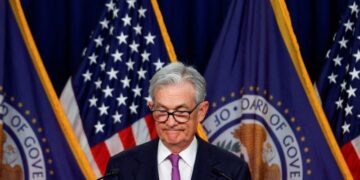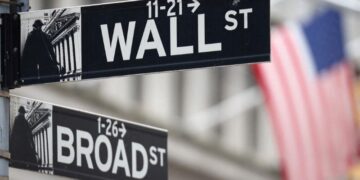Some of big conglomerates will announce their earnings during the week. Tesla and Google parent Alphabet – two of the so-called Magnificent Seven megacap companies whose shares have faltered after two years of stock leadership – are among those closely watched for financial results as investors seek guidance about the fallout from tariffs that are very much in flux. All the Magnificent Seven megacap stocks are sharply lower in 2025, with Alphabet down about 20 per cent and Tesla off 40 per cent.
Investors will also look for US President Donald Trump’s constructive remarks to get a clue about the prospect of any sort of Tariffs deal. If there is any positive remarks, there may be some buying. If a tariff deal is announced then it will be interesting to see whether Nasdaq and S&P 500 can cross 19,000, and 5,500-mak.
The Cboe Volatility index, an options-based measure of investor anxiety, hit around 60 in the aftermath of Trump’s tariff announcement, but has since pulled back to about 30. Still, that level is well above its long-term median level of 17.6, according to LSEG Datastream.
US Stock markets were closed on Friday for holidays ahead of Easter. On Thursday, the S&P 500 edged up by just 0.1 per cent to 5,282.70, even though three of every four stocks climbed in the index. The Nasdaq composite slipped 0.1 per cent to 16,286.45 in a mostly steadier performance following its sell-off the day before. Dow Jones Industrial Average dropped 527 points as insurer UnitedHealth Group fell 22.4 per cent, its worst drop since 1998. The Russell 2000 index of smaller companies rose 17.14 points, or 0.9 per cent, to 1,880.62.
However, for the year, S&P 500 is down 598.93 points, or 10.2 per cent, Dow Jones is down 3,401.99 points, or 8 per cent, Nasdaq is down 3,024.35 points, or 15.7 per cent, Russell 2000 is down 349.53 points, or 15.7 per cent.
FAQs
Q1. What are indexes of US Stock Market?
A1. US Stock Market indexes are S&P 500, Nasdaq, and Dow Jones.
Q2. What is current level of Cboe Volatility index?
A2. Cboe Volatility index, an options-based measure of investor anxiety, hit around 60 in the aftermath of Trump’s tariff announcement, but has since pulled back to about 30. Still, that level is well above its long-term median level of 17.6, according to LSEG Datastream.

















